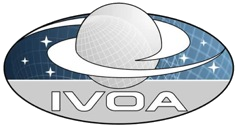IVOA Newsletter - March 2022
The International Virtual Observatory Alliance (IVOA) was formed in June 2002 with a mission to facilitate the international coordination and collaboration necessary for the development and deployment of the tools, systems and organizational structures necessary to enable the international utilization of astronomical archives as an integrated and interoperating virtual observatory. The IVOA now comprises 20 VO programs from Argentina, Armenia, Australia, Brazil, Canada, Chile, China, Europe, France, Germany, Hungary, India, Italy, Japan, Russia, South Africa, Spain, Ukraine, the United Kingdom, and the United States and an inter-governmental organization (ESA). Membership is open to other national and international programs according to the IVOA Guidelines for Participation. You can read more about the IVOA and what we do at http://ivoa.net/about/.
What is the VO? The Virtual Observatory (VO) aims to provide a research environment that will open up new possibilities for scientific research based on data discovery, efficient data access, and interoperability. The vision is of global astronomy archives connected via the VO to form a multiwavelength digital sky that can be searched, visualized, and analyzed in new and innovative ways. VO projects worldwide working toward this vision are already providing science capabilities with new tools and services. This newsletter, aimed at astronomers, highlights VO tools and technologies for doing astronomy research, recent papers, and upcoming events.
IVOA NEWS
2021 Northern Fall Interoperability Meeting Overview
Janet Evans, Marco Molinaro and Patrick Dowler
The Northern Fall Interop meeting was held Nov 02-04, 2021 via Zoom with 182 registered participants from all around the globe. Interop meetings are held every ∼6 months and this was our fourth virtual meeting since the start of the global pandemic. Sessions were recorded and posted so that if you missed a session you can go back and view it. Here is the link if you are interested in session videos. The sessions were led by the IVOA Working Groups (WG) and Interest Groups (IG) and focused on core topics related to status and discussion of current group efforts. Community presentations were solicited and folded into sessions to provide a balance between contributed and core topics. In addition a Newcomers session and a session sponsored by the Committee for Science Priorities (CSP) rounded out the meeting. The Newcomers session was sponsored by the Education Interest Group and held the day before the opening of the Interop. Several scientific use cases were demoed using VO-standards and protocols. The aim was to help newcomers understand the structure of the IVOA and how Interop meetings are organized in order to get the most out of the upcoming meeting. We plan on regular Newcomers sessions at Interop meetings going forward. The CSP session titled “Bringing services and tools to the research community” welcomed presentations by projects on their IVOA support status and community involvement. Panelists from NASA Astronomical VO (NAVO), IPAC, Spanish VO, Chandra, ASVO, and ESA presented overviews of their project efforts. A discussion led by the CSP chair followed and focused on topics of interest and a vision toward the future.
A new and important IVOA Architecture document (lead author Pat Dowler) was released just before the meeting. The document represents the current status of the IVOA Architecture. You can find descriptions of the IVOA Level 0, 1, and 2 architecture, a dependency diagram showing the relationships between IVOA standards, a summary description of each standard, and links to each of the full standard documents. Here is a link if you are interested in reviewing the document
The Closing Plenary and presentation by the TCG, emphasized progress of standards over the last 6 months, and reminded the audience of the Technical Coordination Group (TCG) and their role in the IVOA. The TCG is made up of Chairs and Vice-Chairs of working groups, interest groups, and committees. They are tasked with building consensus in the WG and community, assure coordination between WG/IG & the Committee for Science Priorities (CSP), liaison with the Executive committee, and support committee roles in the IVOA documents and standards process. TCG membership has a 3 year term with a possible 1 year extension. Members of the astronomical community are welcome to get involved in the IVOA and to consider a role in the TCG.
Here are several links to get involved:
| Name | URL | Description |
|---|---|---|
| IVOA Website | https://www.ivoa.net/ | Place to start |
| IVOA Wiki pages | https://wiki.ivoa.net/ | Collaboration area |
| Main Mailing List | interop ‘at’ ivoa.net | IVOA community list |
| All Mailing Lists | https://www.ivoa.net/members/ | Identifies email lists for all WG/IG, CSP & Exec. |
| Slack | https://ivoa.slack.com/ | Collaboration slack channel |
| Github | https://github.com/ivoa | Collaboration development/new ideas |
| Github | https://github.com/ivoa-std | Standard document development |
SCHOOLS AND WORKSHOPS
Second ESCAPE Virtual Observatory School
Stefania Amodeo
The ESCAPE project held its second international Virtual Observatory (VO) school on February 22-24 and on March 4th 2022. As in the previous schools organised by the Euro-VO initiative, the goal was to promote and enhance the VO as framework to exploit the huge amount of data provided by the ever-growing number of ground-based and space facilities, as well as to gather requirements and feedback from the participants. VO experts gave hands-on tutorials on the usage of VO tools and services in “real life” examples of scientific applications, including the exploration of large catalogues like Gaia, cross-matching of big survey data, exploration of transient events and electromagnetic follow-up of gravitational-wave events. The last day was dedicated to the participants science cases and their own use of the VO-skills learned during the school. Planned initially as a hybrid meeting at the Observatoire Astronomique de Strasbourg and online, the school took place online exclusively due to the persistence of the pandemic situation. More information on the school, including the tutorial material can be found here.
Access more scientific usage tutorials here.
